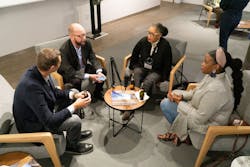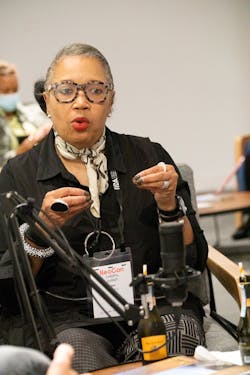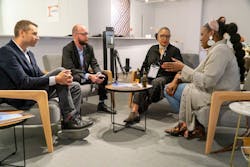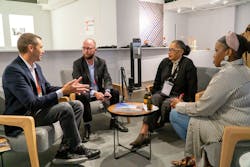i+s Supports IIDA's Design Your World to Promote Diversity in Design
This year, NeoCon looked a lot different than in years past. While attendance may have been down, the energy and positivity were high—and for good reason. Not only did it feel like things were getting back to normal overall, at the i+s showroom on the 10th floor, which featured an interactive installation titled, “Equity Through Education,” that celebrated student design and diversifying the industry, attendees were able to help support a worthy cause just by stopping by and getting their badges scanned.
For every person who visited the i+s showroom, we donated $1 to IIDA's Design Your World initiative, an education pipeline program in partnership with Chicago non-profit After School Matters, working alongside industry partners OFS, 3form, Mannington Commercial, and Configura, granting design education opportunities to diverse high school students. With the support of our generous industry partners (see complete list at bottom), i+s raised more than $13,000 for this new pathway program to design education.
Chief Content Director Robert Nieminen sat down with IIDA CEO Cheryl Durst; interior designer and educator Ciera C. Payton, Assoc. IIDA, senior interior designer at Desa Studio; and Doug Shapiro, vice president of research and insights at OFS, to discuss the Design Your World program and how it is helping to make the profession of design more equitable and diverse. Below is an abbreviated version of the conversation they had at NeoCon:
Robert Nieminen: As you might have noticed when you walked into our showroom, there’s on our video screen with quote from Gabriel Bullock from Perkins+Will that I’d like to read to provide some context for our conversation. She said, “When you think about it, it’s baffling that such a creative profession is not as diverse as it should be. And that if we believe that the more diverse you are, the more creative and successful you’ll be, you think we’d have this figured out.”
RN: Why do we not see more diversity in this industry and what are some of the obstacles that are keeping us from bringing design as a profession to underrepresented communities?
Cheryl Durst: I think we were under an illusion for a little bit. We believed of ourselves what others believed of us. Exactly that quote—why wouldn’t we be open and more diverse? And it just isn’t that simple. Design is a profession that hasn’t historically attracted people of color. There are a lot of misperceptions about design. And I think for communities of color, for first-generation folks and their families, and they’re the first generation to go to college, for immigrant communities, there’s this belief that design isn’t a viable career.
Typically, when you’re coming from those communities, your parents are going to steer you to something that’s known, something that’s expected, something that’s traditional. So, you’re steered into medicine or education. ‘Be a teacher, be a nurse, be something that we understand,’ and design isn’t something that’s understood—and not just by underrepresented communities, but by a lot of people. And so, I think we started out behind the eight ball with people not just understanding design and, therefore, it wasn’t attracting communities of color. But now there’s been this realization, and we’re all working very hard to rectify that. And a design education is expensive.
[Related: Designers Have the Power to Play a Key Role in Strengthening Local Communities]
Ciera Payton: Very much so. Just to touch on what Cheryl said, as well as being expensive, for me, I didn’t know anything about interior design until after high school. I didn’t really plan to do interior design until my college years. For me, I grew up not seeing that. So, to not see it and to not see a person that looks like me definitely makes a difference in what you go to school for.
RN: Cheryl, what was the impetus for launching Design Your World? How did that come about for IIDA?
CD: For me, it was really personal. As a kid, I was in an arts education program, and it exposed an entire world to me. And I always thought if I ever had the opportunity to open up a world for somebody, I would use whatever power and wherewithal I could to do that. IIDA did it, and education has been kind of the cornerstone of my life.
Through everything that IIDA does, we’re constantly exposing design, but also to expose design to a group of students and help them understand that they have access. We call Design Your World a pipeline program, and I often like to refer to it also as a pathway program because we’re opening up a pathway that may not have necessarily existed for a lot of kids. And I don’t want to fall into that trap necessarily of [saying], ‘It’s only kids of color or only kids from certain communities.’ There are so many kids who could benefit from Design Your World, not just folks from underrepresented communities. But it’s always been a dream of IIDA to do a program like this because the more people that we can reach, we can create design champions. We’re not just creating designers, because some of those kids could be future COOs and CEOs, and they become champions of design.
RN: What is the vision and the goals for design your world? How does it address diversity?
CP: Now that I’ve done my first full year of teaching, I would say that the goal for next year is just to get more students excited about interior design or even just the design field period, so they’re exposed to it. Because I really want to focus on showing them other careers they can have with a design degree. And the students didn’t have any idea or clue about that. So that’s one of my main goals—the exposure to the design field.
CD: One of the important goals of the program is just the power in agency that exists in design. And at a time, particularly when many of us feel powerless, that design gives us a certain agency over our environment and surroundings. And so that in addition to, and Ciera did such a great job of exposing the students to the different aspects of design, even just coming to tour the OFS showroom—that opened up a whole world for the students. Like they had no idea that the commercial furniture industry existed. And I remember one kid saying, ‘Wait a second, this is what an office looks like?’ So that just, you know, you could see the light bulbs going off.
RN: Speaking of your partners, what was OFS’ role in getting this program off the ground?
Doug Shapiro: First, I want to say thank you, Cheryl, for the opportunity to be a part of this. It was a huge moment for us. I think that our industry has always done well in that we always understood [equity] in a professional sense. But the demographics, the lack of diversity in our industry is no secret. There’s been a desire to make change, and there’s been a commitment financially, but we’ve never had structure. We’ve never had a repeatable, sustainable program. We didn’t have the competence, even, to go and deliver the change that we are all passionate about. So, it really started off with the conversation with Cheryl about, ‘How do we start?’ And Cheryl was like, ‘Well, it’s funny you should ask ...’ [laughter]
And that was a special moment. To OFS—all of us—it was a moment where we thought, ‘Okay, this is more than just generating excitement. When we talk about this, how do we talk about it from a standpoint of doing something that’s going to take 10 years? Let’s think about it like that.’ And there’s been a lot of great collaboration as a result. The other thing is that it’s not an OFS story—it’s going to take the whole industry. So, how do we create an environment that we’re a part of that invites others to join as well?
CD: And I love the continuity of what OFS brought to the table because, for years, they have supported IIDA and all things student related. They really have staked a claim on things related to students. And I remember you saying once, Doug, ‘How do we get more students?’ That was a bit of a light bulb moment for me even though I know that enrollment in design programs has gone up, but also the attrition rate. People get to design school and they don’t stay. And there are a variety of reasons—sometimes it’s money and sometimes it’s ...
CP: Not what they expected?
CD: Right. Expectations have not been accurately managed, but sometimes there’s this incredible desire to stay there. But many of these students look around, and they’re the only person of color in their class. They are different, they feel alone. And so, we want to create a whole new cohort of students in design school.
RN: Doug, why was it important for OFS to support design education and students and exposing them to design education through Design Your World?
DS: Thank you for asking. I would say just in general, what’s been great about being part of a family-owned business has been this really long-term commitment to sustainability. And we’ve always done it with trees—we’ve always been really big on planting trees. You never do that really for yourself or the next generation. You do it because it’s part of who you are and because it’s part of what you believe in—building a country that you don’t see. And that’s what creates great civilizations. Right? So, this was just like that—we had that light bulb moment. This is how we build a better future.
RN: What are your hopes for Design Your World program and what do you want the design community to know?
CD: We want the design community to know that it exists. We want more participation. We want to expand the program. We did one city and a handful of students. We want more cities and more students. We want to change what the profession looks like and feels like and ignite that fire and passion in this next group of students.
And the other piece on my wish list is, I want their parents to understand design because it’s critical. We hear from so many designers that their parents didn’t support them in design school. They didn’t understand what a career in design meant. I think in any kind of pipeline or pathway program, there is that critical element of educating the parents as well.
DS: I would say the goals and vision for the program are in great hands. I know those will be managed. I think we look at it as a partner, ‘What can we best bring to the table?’ I think one of the things we can do is just help spread the word. We can tell the story of Design Your World. Even if people don’t get involved directly in Design Your World, maybe they do their own thing. That’s what we’re hoping for is just to tell the story and bring others into the program.
CD: There can’t be too many of these programs. If people out there are inspired by this and want to do something in their local community, and we can’t get there or we aren’t there yet, I say more power to them. Just get out there, support in whatever way you can. And thank you [i+s] for what you’re doing. You’re helping us tell the story and putting in some cash. We love that. That’s amazing. So, thank you for that.
Thank You to Our Partners
We want to thank the following manufactures for generously donating to the Design Your World campaign through i+s' Equity Through Education outreach at NeoCon, including:
To learn more about Design Your World, visit iida.org or watch this video:
About the Author
Robert Nieminen
Chief Content Director
Chief Content Director, Architectural Products, BUILDINGS, and interiors+sources
Robert Nieminen is the Chief Content Director of three leading B2B publications serving the commercial architecture and design industries: Architectural Products, BUILDINGS, and interiors+sources. With a career rooted in editorial excellence and a passion for storytelling, Robert oversees a diverse content portfolio that spans award-winning feature articles, strategic podcast programming, and digital media initiatives aimed at empowering design professionals, facility managers, and commercial building stakeholders.
He is the host of the I Hear Design podcast and curates the Smart Buildings Technology Report, bringing thought leadership to the forefront of innovation in built environments. Robert leads editorial and creative direction for multiple industry award programs—including the Elev8 Design Awards and Product Innovation Awards—and is a recognized voice in sustainability, smart technology integration, and forward-thinking design.
Known for his sharp editorial vision and data-informed strategies, Robert focuses on audience growth, engagement, and content monetization, leveraging AI tools and SEO-driven insights to future-proof B2B publishing.





